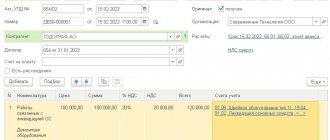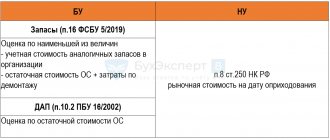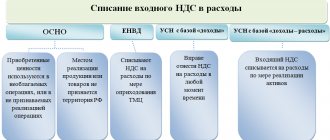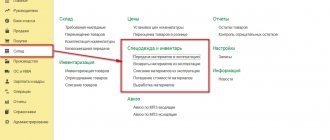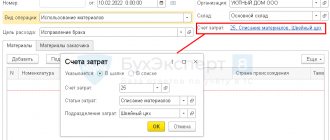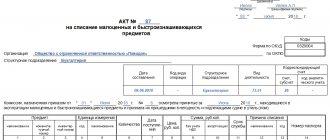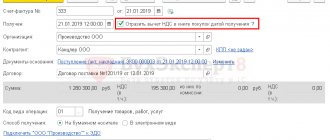What applies to low-value and high-wear items?
In all organizations, one way or another, there is inexpensive and not particularly valuable property that is used in current work. It is not reflected as a fixed asset and its cost is quite small. This includes:
- computer and office equipment;
- Consumables;
- pieces of furniture;
- workwear;
- dishes;
- cleaning and detergents, etc.
This group also includes some tools, equipment, inventory, spare parts, in general, everything that is used to solve various problems in production, but quickly wears out and requires constant replacement.
In order to determine that an item is truly of low value and wears out quickly, you need to make sure that its shelf life does not exceed one year, and its cost does not exceed 40 thousand rubles.
The meaning of the write-off act
All property that the organization has must be recorded in special documentation. The fact of its presence has a direct impact on taxation (although only when using certain schemes, for example, the general tax system).
At the same time, in order to get rid of the property registered to the enterprise, it is necessary to draw up a special act - such a document allows you to write off unnecessary, obsolete, worn-out materials, equipment, etc. in a legal way.
For each type of inventory, there are different forms of documents; there is a special form for writing off low-value and wear-and-tear items.
Creation of a commission
Any property of an enterprise is written off, as a rule, by a specially created commission. It may include both company employees and third-party experts.
The appointment of commission members occurs by drawing up an appropriate order, which also approves the need to write off low-value items and which is issued on behalf of the director of the organization.
Members of the commission perform the following actions:
- study technical documentation (if any),
- certify the fact that the property has fallen into disrepair, is outdated or worn out,
- looking for reasons for this
- record that repair and further use of these inventory items is impossible.
Features of drawing up an act, sample
Today, there is no mandatory, unified form of an act for writing off low-value and wear-and-tear items, so employees of enterprises have every right to write an act in any form or, if the organization has a developed and approved sample document, according to its template. In addition, very often company representatives prefer to use the previously generally used form MB-8. This is due to the fact that it is clear and convenient in structure, contains all the necessary information, and there is no need to rack your brains over the composition of the document.
Filling out the header of the MB-8 form
The “header” of the form contains several lines for approval by its director - without his autograph the act will not acquire legal force. Then it is indicated:
- number assigned to the act;
- name of the organization and structural unit in which the write-off occurs, its OKPO code.
Filling out the front page of form MB-8
Under the “header” of the document there is the first table, where the following is entered:
- date of drawing up the act;
- transaction type code (in accordance with the classifier);
- structural unit that writes off inventory items;
- type of company activity (according to OKVED);
- information about the subaccount and analytical accounting code.
Below you enter the date of formation of the commission, the order number and the fact of write-off is recorded.
The second table includes detailed information about the property being written off:
- its name,
- quantity,
- cost,
- date of receipt,
- service life,
- reason for write-off and other characteristics.
Filling out the back page of form MB-8
On the reverse side of the act, there is first a continuation of the previous table, at the bottom of which the totals for the items being written off are summarized. Below it is indicated the total number of items, numbers and dates of their disposal. The last table of the act includes information about disposal.
The main features of the IBP for inclusion in the write-off act
Workwear wears out quickly
Due to the short service life of SBPs, they must be written off when preparing financial statements.
For this purpose, a special form MB-8 is used, an act for writing off low-value and wearable items.
How can we determine that an item belongs to the IBP and can be included in this document?
How to correctly apply the rationale for things and materials so that they truly are IBP.
From the name of such materials it can be understood that the criteria for including such production equipment in this group are low price and rapid wear.
The time limit for suitability for classifying things as IBP changed periodically. Only the service life remained constant for one year.
Based on these justifications, it can theoretically be assumed that there are 4 main options for evaluating purchased items for the group we are considering:
- The price of the item is below the monetary limit, but its useful life may be more than one year.
- The cost of the inventory is more than the limit, but it is suitable for use for up to 1 year.
- The material does not exceed the cost of purchasing it from the established upper limit, but will last more than 12 months.
- The item lasts less than 1 year and costs less than the price limit.
Quite recently, only by the fourth characteristic of an object could it be included in the IBP. As for the first, second and third groups, previously these were fixed assets. At the same time, in production they often resorted to a price limit, without taking into account the service period.
In this way, IBEs were formed into an independent group, which was dealt with by entire departments of institutes, conducting various studies on them.
Form MB-8. Write-off act: sample filling
You can fill out the document manually or on a computer. To avoid mistakes in registration, fill out the MB-8 act. Put a dash in the empty lines - then you won’t be able to enter false information there.
Download form MB-8: sample filling
Get a sample act for free!
Register in the online document printing service MoySklad, where you can: completely free of charge:
- Download the sample act you are interested in
- Fill out and print the document online (this is very convenient)
The header must have the director’s signature - without it, the document is invalid. In addition, enter the number, as well as the name of the organization and division in which the write-off occurs.
All members of the commission must sign the act of writing off low-value items.
If you are writing off several items that belong to different types, for example, office equipment and furniture, draw up a separate document for each of them. The general form MB-8 of the write-off act is drawn up for items of the same type. For example, you can combine a printer, scanner and phone in one document.
You can quickly fill out the act in the MyWarehouse service. Just enter the information about the IBP on the website and print the finished document.
How to draw up an act?
To draw up an act, a special type of information is provided. The form was developed according to the MB-8 form, approved at the legislative level of the Russian Federation. The document code is indicated in the OKUD classifier with the value 0320004. But, despite the same requirements for the execution of this act, organizations can edit it and make their own changes for ease of filling out.
Before you begin to draw up documentation for the write-off of an IBP, a decision must be made about this by the management of the organization. It can also be accepted by representatives of the commission, which includes experts.
The order to appoint competent members of the commission is issued by the head of the organization.
During the work, members of the commission examine quickly worn-out equipment and study the technical documentation attached to it. Thus, the degree of wear and suitability of the inspected tools and other materials associated with the production process is established.
When writing off certain items, the commission is based not only on examination data. All characteristics set out in the technical documentation are taken into account.
When filling out the columns of the form for writing off IBP, their initial cost is first displayed. It is taken from the costs that were actually spent on their acquisition or production.
If it is decided that such items can be sold, then this can happen either at the same cost or at a price different from the original price of the product. It must be taken into account that when they are sold for an amount exceeding their cost, the difference must be included in the organization’s income.
In other cases, an act is drawn up for the write-off of low-value and wear-and-tear items, the form of which is filled out separately by type of similar items in a single copy. The completed form is transferred to the warehouse together with the MBP to be disposed of.
Storekeepers are required to sign the form to confirm that materials have been written off. From the warehouse, the document goes to the accounting department as a fundamental act for removing unsuitable materials and tools from accounting.
The main features of the IBP for inclusion in the write-off act
Working clothes wear out quickly.
Due to the short service life of MBPs, they must be written off when preparing financial statements.
For this purpose, a special form MB-8 is used, an act for writing off low-value and wearable items.
How can we determine that an item belongs to the IBP and can be included in this document?
How to correctly apply the rationale for things and materials so that they truly are IBP.
From the name of such materials it can be understood that the criteria for including such production equipment in this group are low price and rapid wear.
The time limit for suitability for classifying things as IBP changed periodically. Only the service life remained constant for one year.
Based on these justifications, it can theoretically be assumed that there are 4 main options for evaluating purchased items for the group we are considering:
- The price of the item is below the monetary limit, but its useful life may be more than one year.
- The cost of the inventory is more than the limit, but it is suitable for use for up to 1 year.
- The material does not exceed the cost of purchasing it from the established upper limit, but will last more than 12 months.
- The item lasts less than 1 year and costs less than the price limit.
Quite recently, only by the fourth characteristic of an object could it be included in the IBP. As for the first, second and third groups, previously these were fixed assets. At the same time, in production they often resorted to a price limit, without taking into account the service period.
In this way, IBEs were formed into an independent group, which was dealt with by entire departments of institutes, conducting various studies on them.
What are the accounting entries for IBP?
In the process of forming accounting for IBP, several methods have been developed for reflecting them in transactions:
- Upon receipt, they were received and transferred for use with the cost entered into account 12 “Low-value wearable items.” At the end of each month during the year, 1/12 of the purchase price was written off. Although the period of use could exceed a calendar year, the cost of the MBP was subject to complete write-off within 12 months.
- When an item was handed over to the facility’s workflow, the amount was immediately reduced by 50% due to wear and tear. The remaining half was not touched until the final moment of its decommissioning.
Since the second write-off method was much simpler for an accountant, it was preferred by organizations.
When writing off using the first method, its shortcomings were identified. In the month when the MBP was purchased, its full cost was reflected in the entries and unjustified profits immediately increased.
And although in the future the amount gradually decreased due to wear and tear and, accordingly, contributed to a decrease in profits in the future, this was still not entirely correct.
Both methods of writing off IBP are considered imperfect from a scientific point of view. There is another significant drawback in accounting for IBP, which concerns things with very low prices.
To facilitate accounting for products, accountants ensured that low-value funds were immediately written off as operating expenses in the month they were received.
In this case, there is no need to calculate the percentage of depreciation or amortization, which is a convenient point for accounting.
Theorists were outraged by this write-off procedure, but this did not affect the outcome of the case.
Practice has shown the advantages of this method of writing off IBP, since it immediately reduced the revenue side in the month of purchase and made it easier to account for them.
Since the amount of depreciation is included in production costs, it must be taken into account when determining the tax contribution.
As we have already described, very often in practice accounting is carried out in the two most convenient ways:
- calculation of depreciation in the amount of 50% of the original cost when issuing them from the warehouse for operation, and the second half after receiving the decommissioning certificate for the IBP
- reflect 100% wear and tear when issuing MBP to workers to perform production tasks
The law does not provide for strict restrictions on this matter, therefore the enterprise has the right to independently choose the most convenient method of calculating depreciation of the IBP and apply it throughout the entire calendar year.
To enter information on the depreciation of low-value items with a short useful life, use account 13 “Depreciation of IBP”. According to its credit, in correspondence with the production cost accounts, the amount of depreciation of the IBP is shown, and the debit of account 13 from credit 12 reflects the purchase cost of inventory that has been retired.
They formalize the transfer of the IBP into operation for long-term use using an invoice.
In case of their breakdown, damage, loss of tools and devices, the head of the department must draw up a decommissioning act for the IBP. An exception in these cases concerns circumstances in which the worker’s guilt in the unsuitability of the IBP is established, since the cost of a damaged or lost item must be deducted from his salary.
Features of using accounts in IBP accounting, depreciation and basic postings
It is most correct for an enterprise in the area of low value to use this approach:
- IBPs whose expected lifespan is more than a year should be taken into account on the account. 01 (on the corresponding sub-account).
- MBP that will be in operation for up to a year - on the account. 10 (subcount 9 or 10).
- In the first case, the corresponding subaccount will serve as a contract account. 02.
- In the second: to the account. 10 (10) → count. 10 (11).
- On the account 10 (9) takes into account inventory and household supplies, so it does not need a contract.
When a low-value asset will be used in production for more than 12 months, the accountant makes the following notes:
| Accounts | Description | |
| Debit | Credit | |
| 08 | 60 | The insignificant assessment was capitalized upon the fact of its receipt |
| 19 (1) | 60 | VAT reflection |
| 01 | 08 | Low assessment transferred to operation |
| 68 | 19 (1) | VAT credited |
| 20 or 23 | 02 | Depreciation has been accrued (you can immediately pay 100% of the value of the low-value property, or part of it for the first quarter or year) |
| 02 | 01 | The depreciation amount is written off (but not before the object is completely written off) |
When using the MBP for less than a year, the postings are as follows:
| Accounts | Description | |
| Debit | Credit | |
| 10 (10) | 60 | IBPs are capitalized according to the facts of their receipt |
| 19 (1) | 60 | VAT |
| 20 or 23 | 10 (11) | Low value is transferred for use |
| 68 | 19 | VAT credited |
| 10 (11) | 02 | Depreciation is written off at 100% of the value of the low value |
Capitalization of inventory and household supplies is carried out according to the account. 10 (9). They will be listed until they go into service. At the same time, this type of low value is written off in its entirety. The cost is included in the costs for the item for which they are used. The wiring is as follows:
| Accounts | Description | |
| Debit | Credit | |
| 10 (9) | 60 | Inventory has been capitalized |
| 20, 23 | 10 (9) | Inventory write-off |
When writing off MBP (with a service life of up to a year) for the corresponding current expenses, their cost is equal to zero. When depreciation is charged in parts, the IBP will have a certain residual value for some time.
Thus, depending on the period of operation of the low-priced asset and the corresponding method of calculating depreciation, a balance is obtained, in the active item of which is the full cost of the IBP, and in the contractual item is a similar minus cost. As a result, the value of the low price is zero.
Example No. 3. The cashier-businessman bought printer paper in the amount of 1,500 rubles for cash. An advance report, supported by a cash receipt, was submitted to the accounting department. It includes VAT - 228.75. The paper has been handed over for use. Accounting entries:
| Debit | Credit | Sum | Operation |
| 60 | 71 | 1500,00 | Advance report received |
| 10 | 60 | 1271,25 | The paper has been capitalized |
| 19 | 60 | 228,75 | Input VAT accepted for deduction |
| 26 (44) | 10 | 1271,25 | The product has been sent to work |
How to issue an order on a commission for writing off an IBP
In order to regulate issues related to the write-off of IBP at the enterprise, a permanent commission is appointed by order of the manager. Who needs to be appointed in such cases and what are the nuances of its design?
The commission must include any persons from the administration of the enterprise who are competent in matters of wear and tear and accounting of small-scale equipment. These can be persons from the engineering and technical staff of the enterprise, accounting department, quality control department, laboratory, if there is one in production. The main thing is that people can competently assess and justify the deterioration of the MBP.
The order indicates the positions and individual details of each member of the commission. Then they enter the reason for issuing the decree: “In order to organize work to establish storage periods for documents, carry out their selection for archival storage and use, I order: Create an expert commission.” Next comes a list of the members of the commission, starting with the chairman.
The issue is not regulated by legislative acts. If one of the commission members is absent at the time of decommissioning, a temporary order is issued to appoint another commission member in his place for the duration of his illness or other reason for not going to work.
What should be included in the act
There are no particular difficulties in documenting the write-off of IBP. For this purpose, the commission or the head of the unit draws up a normative act in the MB-8 form.
The document should reflect the following parameters:
- positions and individual details of commission members
- name of the IBP
- the retiring quantity in units of measurement that is used to account for these materials or products
- reason for write-off
After filling out the information about the recycled IBP, the commission members sign the act. It must also contain the signatures of the accountant for accounting of inventory items and the financially responsible person. After signing by all these persons, the document is endorsed by the chief accountant and the manager.
Typical violations when filling MB-4
Drawing up a disposal act in form MB-4 by the financially responsible person may be carried out with violations. Let's look at the table for the most common mistakes made when filling out this document.
| p/p | Typical violations when filling out an IBP disposal report | |
| Violation | Adjustment methods | |
| 1 | The document does not contain the signature of the employee who accepted the valuables for use. | The disposal certificate must be signed by the employee, since the document is the basis for collecting the cost of damaged property from the employee’s income. |
| 2 | There was a numerical error in one of the cells | You can correct the entry by carefully crossing out the incorrect value and displaying the correct familiarity indicator next to it. In this case, the correction should be certified by the signature of the responsible employee and the phrase “believe the correction.” |
| 3 | The reason for the retirement of the IBP is not specified | This detail belongs to the category of mandatory filling and must certainly be reflected in the act. |
When should you draw up an act for writing off low-value items?
Any company has one or another property that it uses in its activities, but does not reflect in accounting as a fixed asset (FPE), since the cost of such property does not exceed 40,000 rubles. These could be, for example, computers, scanners, printers, some office furniture, etc. Despite the fact that such objects are not considered OS, they have a certain service life, after which the company can no longer operate them. In such a situation, it becomes necessary to write off these property items.
For these purposes, a special act is drawn up.
NOTE! Currently, there is no single form of the act in question that is mandatory for all companies. At the same time, until 2013, this was the MB-8 template, approved by Decree of the State Statistics Committee of the Russian Federation dated October 30, 1997 No. 71a.
Therefore, when writing off low-value property in 2022, a company can use the standard form of the MB-8 act or draw up a write-off act developed independently. The decision on which form will be used for this purpose is fixed in the accounting policy.
Documentation of the fact of write-off must be preceded by a decision of a special commission that a specific low-value object is no longer advisable to use in work.
The document in question is drawn up in 1 copy. As soon as the act is drawn up and the written-off property is transferred to the storage room as scrap, such a document should be transferred to the company’s accounting department.
Attribution to otcdi from what amount in 2022
In January 2022, the organization acquired a fixed asset worth RUB 150,000. The property was registered in February and paid for in May of the same year. This means the amount is 150,000 rubles. need to be divided by 3: after all, there are three quarters left until the end of the year, taking into account the quarter when the OS is put into operation.
Fixed assets
- armored and automotive vehicles;
- production tools, household and office appliances, computing equipment.
- machine tools, power plants, lifting machines and other equipment necessary to ensure statutory purposes;
- fire fighting, special equipment;
- special equipment for key areas of activity;
Starting from 2022, the minimum value has been increased, which allows property to be classified as fixed assets in tax accounting. At the same time, in accounting, the value of this indicator remained the same. As a result, inexpensive objects are now reflected differently in NU and ACC, and this raises questions when applying PBU 18/02 (see “How to apply PBU 18/02 “Accounting for corporate income tax calculations” in practice)”). In this article we will explain how to account for temporary differences, as well as deferred tax liabilities and assets.
Regulatory regulation of accounting for small business enterprises
The federal law determines the requirements for accounting and execution of primary documentation
The order of the Ministry of Finance of Russia approves PBU 5/01 for accounting for inventories
The Decree of the State Statistics Committee of the Russian Federation approved the form of primary documentation MB-8
Order of the Ministry of Finance of the Russian Federation Chart of accounts
Related documents
- Form No. 2-ap (quarterly) (approved by Letter of the Central Bank of July 20, 1993 No. 45 “on the provision of reporting on Form No. 2-ap (monthly) and on Form No. 2-ap (quarterly)”)
- Form No. 2-ap (monthly) (approved by Letter of the Central Bank of Russia dated July 20, 1993 No. 45 “on the provision of reporting on Form No. 2-ap (monthly) and on Form No. 2-ap (quarterly)”)
- Form No. 7-tvn “report on temporary disability and injuries at work” (approved by the Post of the State Statistics Committee of Russia dated 07.07.93 No. 127)
- Form of a report on the activities of an enterprise with an average number of employees up to 200 people (form No. 1-MP, postal - quarterly) (approved by the Post of the State Statistics Committee of Russia dated January 19, 1993 No. 09)
- Report form on the availability and flow of funds from state extra-budgetary funds (form No. 8-f, postal - annual, quarterly) (approved by Resolution of the State Statistics Committee of Russia dated September 11, 1992 No. 147)
- Balance sheet as of March 31, 2012
- Interim liquidation balance sheet
- Information on the credit institution's funds received and used according to the interim liquidation balance sheet
- Order on accounting policies for accounting and taxation purposes
- Order on the accounting policy of a non-profit public organization
- Order on accounting policy
- An example of an accounting policy for an organization with a simplified tax system
- Sample liquidation balance sheet
- Sample liquidation balance sheet of LLC
- Sample interim liquidation balance sheet
- Interim liquidation balance sheet of LLC
- Interim liquidation balance sheet
- Separation (liquidation) balance sheet of the main manager (manager), recipient of budget funds
- Separation (liquidation) balance sheet of a state (municipal) institution
- Letter of credit (form 0401063)
Reason for using MB-8
Despite the fact that there is an approved form MB-8, from 01/01/2013 this form is not mandatory for use in work. Commercial enterprises can develop and approve at the local level their own forms for recording the movement of small and medium-sized goods.
The definition of IBP was given in PBU 5/98 (not in force today) and stated: part of the organization’s materials and equipment used as means of labor for a period of up to 12 months or during the operating cycle (if the cycle is more than 12 months), or have a cost estimate of date of purchase no more than 100 minimum wages (the limit was approved by the organization) and was taken into account on accounts 12 and 13.
Currently, MBP is also the main part of production activity, it is classified as working capital and is accounted for as part of the inventory on the basis of PBU 5/01.
Since IBPs are in constant motion, there is also a fairly large amount of documentation on them. An act for writing off the IBP (MB-8) is used when:
- loss
- damage
- expiration of service life
- breakdowns, etc.
Example of transactions for writing off an IBP
| No. | Operation | Debit | Credit |
| 1. | Inventory purchased | 10/9 | 60 |
| 2. | Inventory transferred to the machine shop | 23 | 10/9 |
Actual cost of IBP
IBP, like all inventories, are accounted for at actual cost, which is the amount of costs upon acquisition, minus VAT.
The costs of purchasing an IBP include the following payments made by the enterprise:
- based on the supplier agreement
- customs duties
- taxes that are not refundable
- intermediaries
- for procurement and delivery (including insurance)
- to bring the MBP to the required state
The procedure for filling out the MB-8 form
Federal Law 3 for the preparation of documents (regardless of whether a unified or independently developed document form is used) identifies the following mandatory details:
- full title of the document
- date when the document was drawn up
- organization that compiled the document
- content of the operation performed (recognition of unsuitability and scrapping of the MBP)
- quantity and units of measurement
- positions of persons who completed the operation
- signatures of persons and their decoding
Directly in MB-8 there are design features:
- the corresponding account is indicated
- name of the IBP, its nomenclature and inventory numbers (for each IBP separately)
- date of receipt and service life
- basis, reason for write-off
- sums up the written-off small business enterprises
- registration of scrap or scrap, its destruction indicating the delivery invoice number
- signatures of all commission members are placed in accordance with the order
Step-by-step instructions for filling out MB-4
The unified form of the document is a form that has a front and back side.
The title side of the act includes the following components:
- Retirement act header;
- A table disclosing information about the document being compiled and the IBP accounting accounts;
- A table designed to reflect data about a low-value property;
- A table used to disclose information about the company employees in whose use the item was located.
The header is intended to disclose information about the organization and should reflect the following information:
- Name of the company and its structural division;
- Code in accordance with the OKPO classifier.
Table for displaying data about the document and accounting for low-value items in the company:
- Date of drawing up the act;
- Code of the type of operation being performed;
- Subdivision;
- Kind of activity;
- Correspondent accounts (account, analytics);
- The accounting unit of the object's release.
A table designed to reflect information about the IBP:
- Detailed information about the low-value object (type, grade, size) and item number;
- Unit of measurement of the object MBP indicating the code from the OKEI classifier;
- Quantity;
- Unit price;
- Amount excluding VAT and depreciation amount;
- Reason for leaving the organization (reason code and name).
The totals should be summed up in the “amount” columns. Below this table are the lines used by the employee responsible for drawing up the document to reflect in detail the reasons for the departure of the IBP object from the company.
We recommend that you familiarize yourself with a sample of filling out the MB-4 form.
Important! The title side of the form must be signed by the performer of the work.
The reverse side of the disposal certificate form is used to demonstrate data about the employee (workers) who had in use a specific item of low-value property. In this case, the table should provide interested users with the following information:
- Last name and initials of employees;
- Employee personnel number;
- Date of actual transfer of valuables;
- Signature of the person responsible for issuing the objects;
- Data on the calculation of the amount of deduction from guilty employees (percentage of accrued depreciation, cost minus accrued depreciation, type of deduction code, percentage and actual amount of deduction, amount of monthly contribution);
- Signature of the guilty employee.
Important! The completed document form must be signed by the head of the organization’s department, the storekeeper and an accounting employee.
Synthetic and analytical accounting of IBP
Synthetic accounting of IBP is maintained on account 10 Materials; subaccounts are allocated for IBP:
- Inventory and household supplies
- Special equipment and special clothing in stock
- Special equipment and special clothing in use
Analytical accounting is maintained for each type of IBP, for which the enterprise can create a journal that reflects the availability, issue, MOL, etc.
Include the cost of low-value property as part of material expenses. In this case, the organization has the right to independently establish the procedure for writing off such property in its accounting policy for tax purposes.
State Advisor of the Tax Service of the Russian Federation, 1st rank E. Popova
What is important to remember to fill out the form correctly
Filling out the act in form MB-8 does not present any difficulties. In particular, it is required to indicate:
- name of the object being written off;
- its nomenclature and inventory numbers;
- unit of measurement;
- cost and number of objects being written off (if they are of the same type);
- passport number of the item being written off;
- the date when operation of the facility began;
- date and reason for write-off.
After the act is completed and executed, both the chairman of the commission and all its members put their signatures at the end of the document, indicating their initials and positions.
The procedure for drawing up the act is completed by the storekeeper, who marks the date of acceptance of the written-off low-value property into the warehouse.
The composition of the information reflected in the act developed independently should be similar.
You can download a completed sample based on the MB-8 form on our website.
IMPORTANT! If it is simultaneously decided to write off several items at once, the MB-8 act must be issued separately for each such item, if they belong to different types. A general act can be for several items of the same type.
Is it necessary to restore the asset to the balance sheet?
In practice, many accountants are not limited to the above entries. They create an additional operation, the essence of which is to restore previously written-off values on the balance sheet.
This is done due to the fact that a number of accounting programs do not provide for a standard transaction for the sale of “off-balance sheet” property. And in order to carry out such an implementation, one would have to create postings manually, which is extremely undesirable. In addition, without a standard operation, the program cannot automatically generate a shipping invoice, and you have to issue this document yourself. Therefore, in order to “deceive” the program, the asset is first debited to account 10 again, and only after that the sale is completed.
However, it is impossible to restore an asset at its actual cost, as this will lead to the creation of income and expenses that actually do not exist. For this reason, the object is re-listed not at real, but at symbolic value - for example, equal to 1 kopeck. In this case, the accountant makes the following entries:
DEBIT 10 CREDIT 91 subaccount “Income” – 0.01 rub. — the asset is capitalized for sale; DEBIT 91 subaccount “Expenses” CREDIT 10 – 0.01 rub. — the cost of the asset is written off
As a result, the program allows you to easily sell an object that is included on the balance sheet along with other materials. At the same time, all necessary transactions are created and a printed form of the shipping invoice is generated.
What should be considered low-value and wearable property
For a long time, low-value and wearable items were taken into account in account 13. But now it is missing, although the MBPs themselves have not disappeared anywhere. By all criteria, this material resource should be classified as fixed assets, but its value is too small to be included in the corresponding OS account (01). Therefore, although the term IBE is not used in professional accounting language, low value is present.
It includes current assets for which:
- cost - for one unit no more than 40 thousand rubles;
- operating time - up to a year or two;
- subsequent resale is not envisaged.
They are also characterized by:
- application in the manufacture of goods directly or for the purpose of managing the production process;
- assistance in generating income.
Low-value property is included in current assets, and their value is written off as expenses:
- completely, provided that the service life is one year;
- in parts, when he is 2 years old.
Although small business enterprises are written off, they continue to be reflected in accounting (not in tax accounting) as part of industrial property. And at the enterprise, their movement must be constantly monitored to ensure safety. It is for the safety of the physical value that low value, even with zero value, is taken into account in the documentation. And this happens before it is completely worn out. The accounting policy should establish the maximum value of low-priced items.
IBP are items that are purchased by an enterprise in order to use them for a long time. But their cost is immediately written off in full to the cost of production.
Example No. 1. The organization bought a filing cabinet, paying 25 thousand rubles for it. (without VAT). This acquisition relates to furniture, that is, to fixed assets. But since its cost is less than the established limit (40 thousand rubles), the table is considered low-priced. 25 thousand rubles. written off to management expenses immediately upon commissioning.
General provisions
Low-value wear-and-tear items (hereinafter referred to as LBP) are a special type of inventory (clause 6 of P(S)BU 9). Their main features are: low cost and, due to rapid wear and tear, a short period of use - no longer than one year.
The following can act as IBPs:
- various tools and devices, special equipment;
- household equipment;
- means of protection against the harmful effects of the working environment (working clothes, safety shoes);
- containers that enterprises use to store inventory in warehouses, production workshops, and during transportation (clause 6.2 Method of Recommendations No. 2).
IBPs are accounted for in account 22 of the same name - provided that they are used for no more than a year or a normal operating cycle, if it lasts more than a year (Instruction No. 291).
IBP are included in the balance sheet at original cost
(clause 8 P(S)BU 9). The procedure for determining the initial cost of inventories is given in paragraphs 9–13 of P(S)BU 9.
Upon commissioning
IBEs are excluded from assets, and their value is written off from the balance sheet to the appropriate expense accounts. Then it is necessary to organize operational quantitative accounting of MBP at places of operation and responsible persons during the period of their actual use (clause 23 P(S)BU 9, clause 2.22 of Method Recommendations No. 2). At the same time, it is convenient to conduct analytical accounting of small business enterprises by their types, homogeneous groups, etc., based on the needs of the enterprise. SBPs can also be written off from the balance sheet if they are damaged or out of stock.
If the MBP is returned from service to the warehouse
and are still suitable for further use, then they are again included in account 22 at net realizable value. Net realizable value is the expected selling price of an IBP minus the expected costs of its sale (clause 26 P(S)BU 9). At the same time, income for the same amount is recognized (entry Dt 22 - Kt 719 “Other income from operating activities”).
As of the balance sheet date, small items in stock may be discounted
to the net realizable value or additionally valued within the limits of the previously carried out markdown in accordance with clauses 24–28 P(S)BU 9. In this case, expenses are recognized in accounting (entry Dt
946
“Expenses from depreciation of inventories” - Kt
22
) and income (entry Dt
22
– Kt
741
“Other operating income”).
To document transactions related to the movement of small business enterprises, standard forms of primary documents approved by Order No. 145 are used. But to record the movement of small business enterprises, you can use both standard forms provided for by law and independently developed ones. However, independently developed documents must contain all the required details.
What is considered low value in 2022 from what amount?
Despite the fact that these resources correspond to the characteristics of fixed assets, it is impossible to take them into account as part of these assets due to their paltry cost, which is incomparable with the price of fixed assets. Therefore, IBE includes assets procured or purchased directly for production needs and contributing to an increase in income received.
Sources
- https://assistentus.ru/forma/mb-8-akt-na-spisanie-malocennyh-predmetov/
- https://VyborPrava.com/trud/kakoj-inventar-vnosit-v-akt-na-spisanie-malotsennyh-i-bystroiznashivayushhihsya-predmetov.html
- https://k-nt.ru/provodki/malocenka-do-kakoj-summy.html
- https://online-buhuchet.ru/mb-8-akt-na-spisanie-malocennyx-i-bystroiznashivayushhixsya-predmetov/
